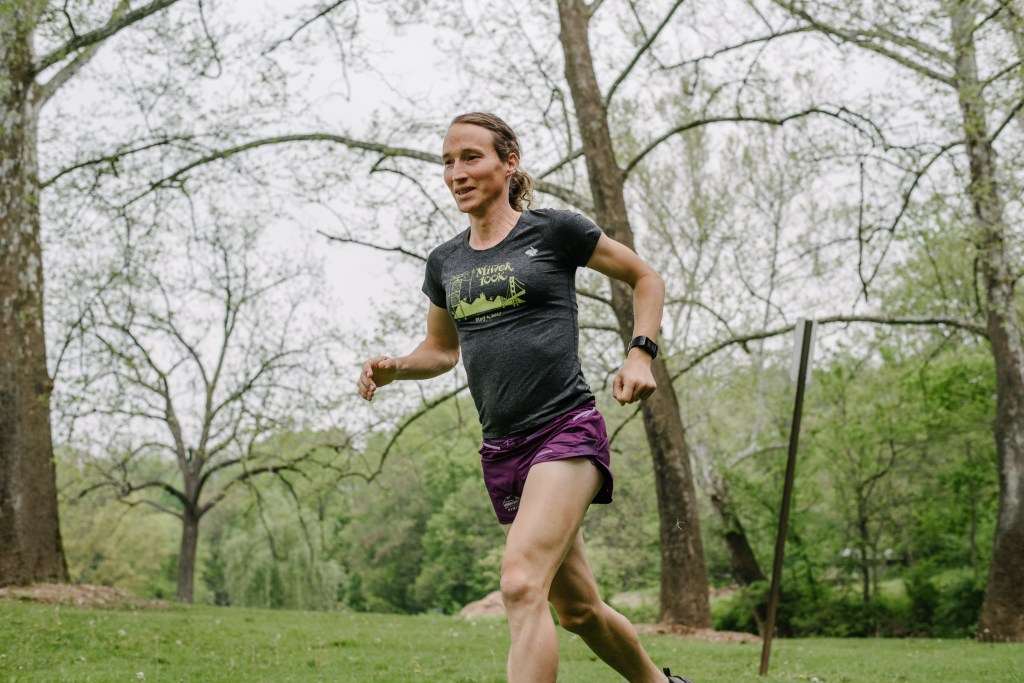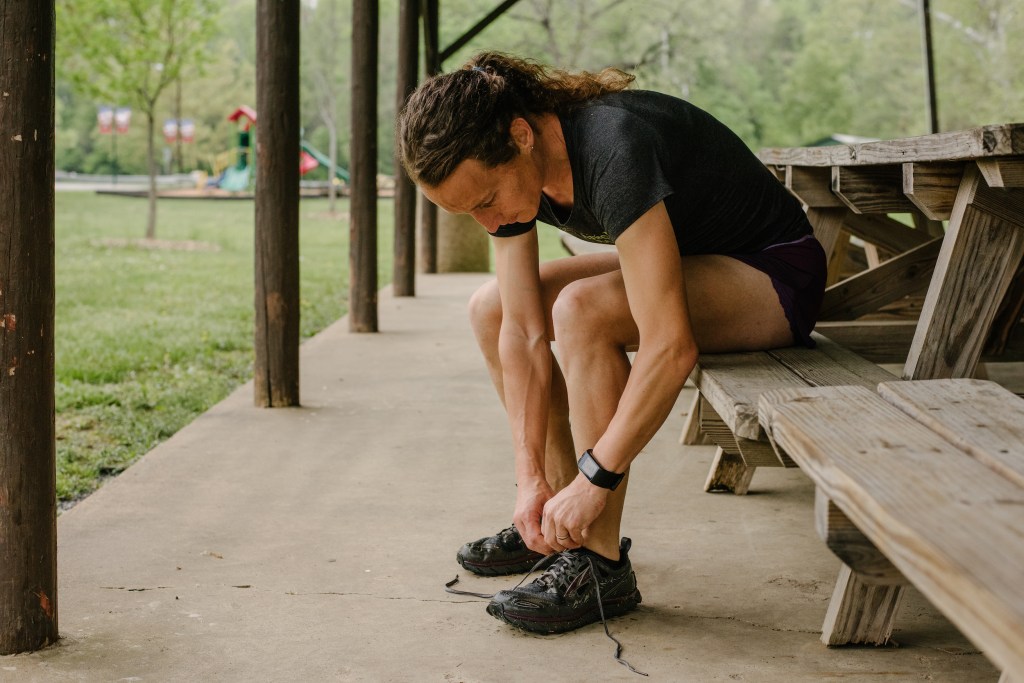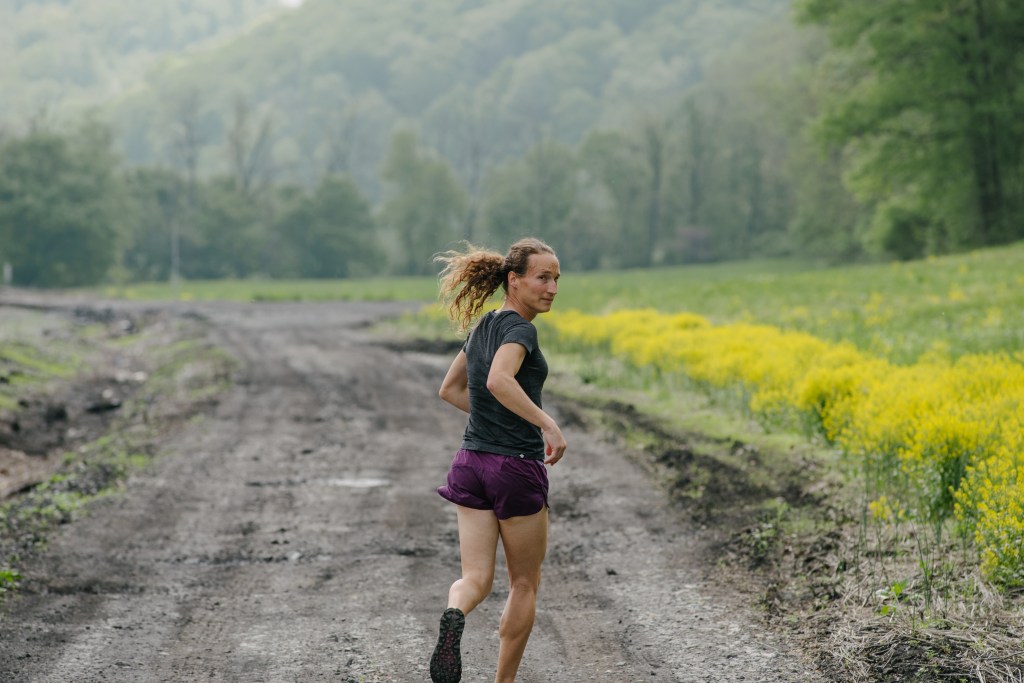Standing at the starting line of the Western States Endurance Run, a 100-mile trail-running race that takes place in late June in the high peaks of California’s Sierra Nevada, Grace Fisher has a mantra: Smile every mile. It’s something her coach taught her, but it also embodies the effect running long distances has on her days. Running makes her happy.
“I’m more at peace now than I’ve ever been. I’m more content with life,” Fisher said from her home outside Washington, D.C., a few weeks before this past weekend’s Western States race. “Running saved my life in many ways.”
It took six years of unsuccessful lottery results for Fisher to finally earn a coveted spot at Western States, a pinnacle event in the ultrarunning community that always has a lengthy wait-list and thousands of runners who don’t make the cut. This year, 5,862 people applied for 369 spots.
Fisher has had strong results at other ultramarathons: She’s earned multiple top-10 finishes at the Vermont 100 and last September, she placed fifth overall and first in the women’s field in the Yeti 100-Mile Endurance Run in Virginia. But Western States was a life goal of hers. It wasn’t an easy path to the starting line.

Grace Fisher ran the 100-mile Western States Endurance Run this past weekend. (Credit: Andrew Mangum)
To understand this fully, you have to go back in time to when Grace wasn’t yet Grace. Born to a Mormon family an hour north of Salt Lake City and assigned male at birth, Fisher started running in high school, in a summer track club. After graduating, she served for two years on a Mormon mission in Hungary and running didn’t fit into her lifestyle there, so she put it on hold.
After college at Utah State University, she got a job working for the U.S. Army at a military proving ground for new weapon testing in Yuma, Arizona. She married her first wife, and they had two children. At first, she didn’t have the time or desire to run. “Working 60-hour weeks or more and with the stresses of life, I needed some kind of release,” she said. So, she started running again on a flat, two-mile loop near her house.
It helped, but it didn’t fix the bigger issues she was dealing with. She was depressed and struggling in her marriage. Still living as a man, she found herself dressing in women’s clothes in secret.
“I felt alone,” she said. “I didn’t know what it was exactly, but my outlook on life was, I’d say, stormy.” Eventually, Fisher went to a therapist, who helped her process her feelings. She and her wife divorced in 2012.
She never planned on transitioning, but she met a new partner and the woman who became her second wife encouraged her to explore her options. Fisher joined a support group for people who are transgender.
“Having that safe space really helped me to decide to transition,” she said. “Realizing that there were other people out there like me, I no longer felt alone.” In late 2013, she began taking the first steps toward coming out as a woman.
When she started transitioning, which for Grace included hormone treatment, her second-oldest son, who was four years old at the time, would tell others, “Daddy feels like a girl on the inside.”
“That was a bit awkward, but kids are so accepting of things adults can’t always wrap their heads around,” Fisher said.

Fisher says that running is where she feels most like herself. (Photo Credit: Andrew Mangum)
Now 38, Fisher works as an analyst for the federal government in Washington, D.C. She and her wife have two children of their own, the youngest born just this year, and they’re also raising the two boys from Fisher’s previous marriage. She makes running a regular part of her busy life.
After returning to the sport while living in Arizona, she started logging about 40 miles per week and would sign up for the occasional 10K race. When one of her friends was training for a marathon, she ran 16 miles on a training run, the farthest she’d ever gone. Once, while on a trip to Monterey, California, she went for a jog on the beach and ended up covering 14 miles on a whim. “I loved it,” she said. “Running is where I felt like myself.”
She read the popular book Born to Run, but remembers thinking, “Running 100 miles? That’s crazy.” She signed up for her first marathon, then a friend encouraged her to try a 50K. For many years, she entered races as male. But starting in 2014, she began entering races consistently as female. Nobody seemed to notice.
Fisher is hardly the first ultrarunner who is transgender. Ultrarunner Amelia Gapin, who is transgender, appeared on the cover of Women’s Running in 2016 and started a Facebook group for runners who are transgender. Bo Aucoin, an ultrarunner and triathlete, was assigned female at birth and has come out as male. There are certainly others, including those who may be transgender but don’t feel safe enough to come out. Fisher said the ultrarunning community in general has been incredibly welcoming to her and others.
By 2016, she still hadn’t changed her name legally, but when she signed up for the Boston Marathon as female, she asked the race organizers if she could run under her new name, Grace Fisher. But the night before the race, without her knowing it, her gender in the entry data was changed to male. She’s not sure how that happened, but after the race, Fisher worked with the organizers to change it back to female. In 2018, in response to Fisher and several other runners who are transgender participating in the Boston Marathon, race officials issued a statement, saying that athletes can enter the race in the category that aligns with their gender identity.
It was a big step for the running world. Other races are starting to follow suit, and in February of this year, Western States created an official policy on entrants who are transgender, making it one of the first ultramarathons to address the issue head on.
“We were notified that Grace was selected in the lottery,” said Diana Fitzpatrick, a board member of the Western States Endurance Run. “We felt it was better for us as a race organization to put together a policy so we weren’t caught off guard and scrambling to put together rules. We wanted the language to be as inclusive and welcoming as possible to transgender runners, but we also wanted to make it clear that we took into account fairness issues for all competitors.”
The committee spent months examining existing policies, including those of USA Track & Field, the National Collegiate Athletic Association and others, before drafting their own version, which states that a runner’s self-declared gender at registration will be taken at face value and there will be no tolerance of a challenge to a runner’s self-declared gender unless a top-10 finish or age group award is at stake. If a runner’s top-10 results are challenged, they may be asked for documentation from a doctor or other certified professional showing that they have undergone medically supervised hormone treatment for gender transition for at least a year prior to the race.

It took six years of applying for the lottery for Grace Fisher to earn a spot in the Western States Endurance Run. (Photo Credit: Andrew Mangum)
At Western States, the smile every mile ethos worked for Fisher. She placed 20th amongst females, finishing the race in 22 hours, 59 minutes, well under her goal of 24 hours.
When asked what she would say to someone in her position 10 years ago—someone struggling with who they are and their place in the world—Fisher paused, then stumbled over an answer.
“I’d say, ‘Follow your heart,’” she said. “I’ve learned that self-care is important. Be honest and open with yourself and others.”
Later, Fisher would go for a long run and ponder this question. How could she help others who feel alone or haven’t revealed who they really are? Transgender or not, finding one’s identity is perhaps life’s greatest challenge. Running can help answer those big questions. She returned home from her run, then jotted down a more thorough response.
“I would tell them to go for it, try it out. Do anything but keep silent,” she wrote. “Tell someone what you’re feeling, whether it’s a therapist, a significant other or a stranger on the bus. There is so much healing power in telling someone. In coming out.”


